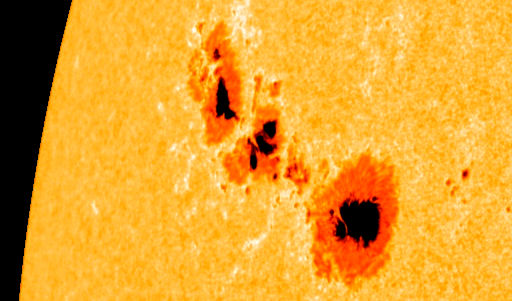The impact of a coronal mass ejection resulted in strong compression of our planet’s magnetosphere.
By NASA’s Goddard Space Flight Center, Greenbelt, Maryland — Published: September 27, 2011
Sunspot 1302 has already produced two X-flares (X1.4 on September 22 and X1.9 on September 24). Each of the dark cores in this image from SDO is larger than Earth, and the entire active region stretches more than 62,00 miles (100,000 km) from end to end.
Photo by NASA/SDO/HMI
A strong-to-severe geomagnetic storm is subsiding following the impact of a coronal mass ejection (CME) at approximately 8:15 a.m. EDT September 26. The Goddard Space Weather Lab reported a strong compression of Earth’s magnetosphere. Simulations indicate that solar wind plasma penetrated close to geosynchronous orbit at 9 a.m. Geosynchronous satellites could therefore be directly exposed to solar wind plasma and magnetic fields. Clear locations as far south as the northern United States were witness to aurorae due to the storm. Skywatchers at the highest latitudes should remain alert for northern lights as Earth’s magnetic field continues to reverberate from the CME impact.
Behemoth sunspot 1302 unleashed another strong flare on Saturday morning — an X1.9-category blast at 5:40 a.m. EDT. NASA’s Solar Dynamics Observatory (SDO) recorded the extreme ultraviolet flash.
The movie also shows a shadowy shock wave racing away from the blast site. This is a sign that the blast produced a coronal mass ejection (CME) that delivered the glancing blow to Earth’s magnetic field yesterday.
Since the X1.9-flare, active region (AR) 1302 has unleashed M8.6 and M7.4 flares on September 24 and an M8.8 flare early on September 25. None of the blasts have been squarely Earth-directed, but this could change as the sunspot turns toward our planet in the days ahead. NOAA forecasters estimate a 40 percent chance of more X-flares during the next 24 hours. Any such eruptions would be Earth-directed as the sunspot crosses the center of the solar disk. ………
Click here to read the full article in the Astronomy.com website

